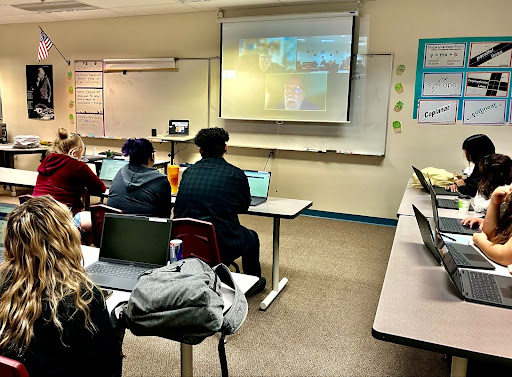
by Steve Waddell | Oct 18, 2022 | Web Pro Education
The Web Professionals Global Organization is proud to work with schools all over the U.S. Today we are highlighting Rocio Reyes, who teaches at the Las Cruces New America School Charter High School in Las Cruces, New Mexico. Rocio’s students are currently working through an animation course and earning Web Animator Certifications from the Web Professionals Global Organization. Executive Director Mark DuBois recently had the chance to speak to Rocio’s class in a video call to share thoughts and answer questions about what it means to be a web professional.
The Web Professionals Global Organization has worked with a number of charter schools like Las Cruces New America School over the years. Parents choose charter schools because they offer something different than traditional schools. Charter schools are often looking for ways to give their students an edge and enable them to set themselves apart in university, community college and the world of work. Rocio saw an opportunity to give her students a chance to set themselves up and stand out through international industry recognized certifications, and the Web Animator Certification does just that.
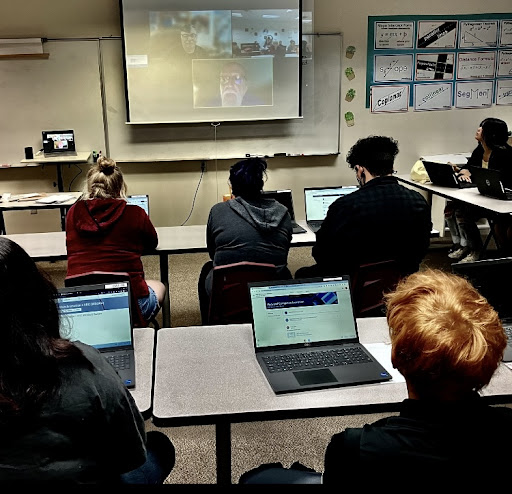
Mark and Steve Waddell of CTeLearning spoke with the class about what it means to be a web professional, the importance of certifications, and how the Animation coursework helps prepare them for future educational and career pathways. Thanks to the Learn and Earn partnership led by CTeLearning and the Web Professionals Global Organization, students in Rocio’s classroom are earning Web Animator Certifications for free. These certifications normally cost $100 per student. The certification costs are underwritten by a partnership between the association, some benevolent industry professionals and CTeLearning. School administrators and teachers love how the model gives students the opportunity to earn valuable credentials without overhead costs for the school or parents.
The students heard about how valuable it is to have industry certifications that employers look for, as opposed to certifications designed by testing companies that don’t measure real-world skills. These certifications prepare the whole learner, ensuring students are proficient in animation while also equipping them to work with others in their professional careers. Mark and Steve talked about how important soft skills like communication are in the global economy, where so many people work with colleagues in other time zones and countries around the world. Being well-equipped to meet both technical and non-technical challenges will make these students attractive job prospects one day.

Rocio said, “Everyone here at LCNAS is looking for a way to give our students a great education, and that includes the confidence and esteem that comes with getting industry credentials. As their teacher, I have to find ways to help my students be future proof. COVID-19 taught us all that we cannot predict the future, but getting my students industry certifications is a way to give them more flexibility regardless of what happens next year or five years from now. Certifications also help them with their college applications. Universities and companies are looking for individuals who stand out, and I want all my students to stand out. I would like to thank my administration for helping me to make this career-building experience happen here.”
Mark talked about how these students are preparing for their futures: “It is always a pleasure to get to chat with future web professionals. The Web Professionals Global Organization is proud of all of our students who have worked through our career prep certification programs. These students realize that they can begin to improve their future educational and career prospects in the classroom and build real-world projects to take with them on whatever the next steps of their journeys might be. The CTeLearning Animation course and our Web Animator Certification prepare students with not only technical skills but also soft skills that are so important for career success in the global economy. The future for these students in our industry is bright.”
Connect with us Today
The Web Professionals Global Organization is proud to award certifications to students in middle schools and high schools as well as adult learners across the country and around the world. If you or someone you know is interested in learning about the rapidly changing world of the web, contact us today. We would love to speak with you.
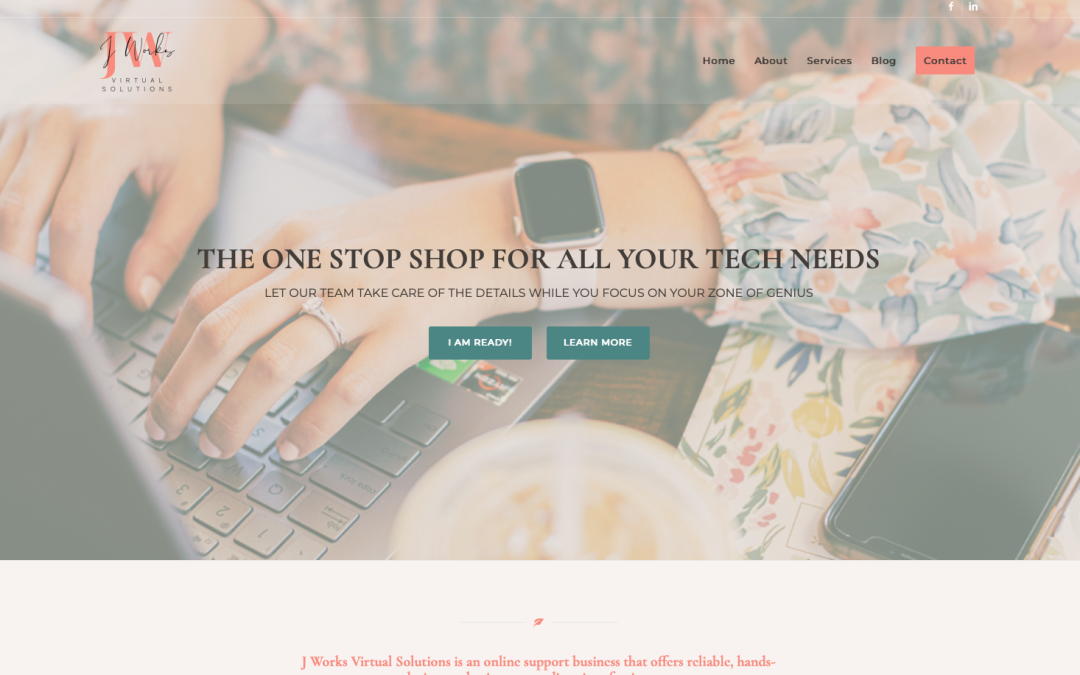
by Steve Waddell | Aug 26, 2022 | Profiles Of Success, Web Design
Today we are highlighting Fabrizzia Kaso, a web design professional who earned her Remote Working Professional certification and is working on completing her Web Design certification with the Web Professionals Global Organization. She designed the website for J Works Virtual Solutions, an online support business that offers reliable, hands-on solutions to businesses needing time-freeing support. Jenna Moser, the CEO and founder of J Works Virtual Solutions, hired Fabrizzia to design a website that would increase the online presence of the business.
We caught up with Fabrizzia to hear about her experience on this project and what life is like as a web designer.
What was your experience like working with this client?
When I first met Jenna she was very nice and wonderful to work with, and I could tell she was passionate about her business. During the process of our work relationship, Jenna was efficient in her response time. She helped bring the project along, delivering all the essential pieces to build a beautiful website. We have valued each other from the beginning, which made it easy for me to start such a fun project with her. I love being able to build relationships that can last a lifetime. I’m glad I had the opportunity to meet Jenna and work with her on her website. She is a true professional, and I know she will succeed in whatever she does.
How did your coursework from Web Professionals Global prepare you for this project?
The course and mentorship provided the foundation for me to understand the basics of how to start a website and work on real-world projects. Today, I am able to build websites from scratch. This starts with brand personality, brand pictures and layout, and includes much more as the process develops. The coursework also taught me the importance of working with others and building a team to draw on the strengths of my professional colleagues.
As you add this project to your portfolio, what did you learn from it that you can apply to future projects?
I learned that I need to be well prepared to start a project. Organizing project finances is important, but it is equally important to have processes and systems in place to ensure the client knows exactly what he or she needs to provide prior to starting the project.
How has this project built your confidence now that you know you can build a website on your own?
It has helped tremendously and I couldn’t be happier with the results. What I liked most was the freedom I had to develop the website from scratch. I based the website on the client’s personality, company values and services. You have to give 100% to every client and honor their trust in you. This is especially important to remember when you are starting out. I see the result of my hard work in the requests from potential new clients to build their websites. I am excited to be able to take on future clients and create beautiful and meaningful relationships along the way.
What would you tell others thinking of starting a career in web design?
I would say that website design is more than just building the site. It is 50% creativity and imagination, 20% strategy, 20% content, and just 10% is the actual website layout. It is much more involved than most people think. Creating a website can be a very rewarding experience. It’s a chance to be creative and use imagination to build something people will see and interact with. But it’s also much more than just making the site. You need to be strategic about how you want people to use your site and what kind of content you’d like to include. And, of course, you need to build the site itself! If you’re feeling excited about creating a website, then it’s probably something you’ll enjoy doing. And who knows—you might even make a career out of it!
Now that you have completed the project, what advice would have been helpful at the start of the project?
Being professional and strategic when working with clients allows you to set yourself up for success and avoid unnecessary delays or cancellations. To prevent this, it is vital to be clear and concise when onboarding a new client. I learned how important it is to have a checklist of needed items and action steps for clients to complete before I start a project. This allows me and the client to be fully prepared for what is necessary for the project to begin. Taking care of this information can minimize the project time to avoid extra hassle. Clear and effective communication is essential for any successful project.
What would you tell others to keep in mind when beginning work with a client?
Professionalism and strategy are two crucial factors to success when working with clients. I recommend setting clear expectations from the very beginning. This will help set the tone for a professional relationship and ensure that both parties are on the same page from day one. Furthermore, being comfortable communicating with the client is crucial. This way, the client will always be updated on the project’s status and will not be caught off guard by any surprises. Finally, maintaining regular communication will build trust and credibility with the client, which are both essential for a successful working relationship.
What do you love about web design?
I love the creativity and functionality behind a well-designed website. Surprisingly, I also enjoyed the copywriting and blog writing aspect. The possibilities and designs are endless when designing a website.
What do you enjoy about working with your clients?
I enjoy sharing my professional worth ethic and values, working with them closely, and creating a bigger impact by establishing a strong client relationship.
Do you have a particular focus for your business?
I focus on discovering brand personality and creating engaging messaging for each of my clients.
What does it feel like when you hand the “keys” over to your client for their brand new website?
It feels like you are rewarding the client with an Oscar or Grammy. The best part is when you see the smile on his or her face. That is the true fulfillment for me.
Connect With Us
Have you wondered what it is like to work as a web designer? Contact us today to chat about our web design certifications as well as all the other certifications we offer. We would be happy to talk with you about how we can help you reach your professional goals.

by Steve Waddell | Jul 11, 2022 | Web Accessibility, Web Conference, Web Design, Web Development, web standards, WOW News
Our organization was proud to help facilitate the web design contest at the national SkillsUSA competition in Atlanta, GA from June 19-24, 2022. Our team arrived on Sunday, set up Monday and Tuesday, and ran the high school competition on Wednesday and post-secondary competition on Thursday. We also organized a Thursday evening debrief and meet and greet with industry professionals and participated in the overall awards ceremony on Friday evening. We would like to thank all our team members for using their vacation time to support SkillsUSA and the web design contest.
This year, the web design contest teams were greeted with messages in Spanish, German, Chinese, French and Arabic from our international members. One of the benefits of our organization is that our community is made up of members from all over the world, and our international experience and membership helps to craft the real-world challenges that our competition delivers. We are about helping to create and support whole professionals ready to work both domestically and internationally—especially in this age of remote work.
The Contest
The competition was held at the Georgia World Congress Center, and the competitors were teams of two from different states in the country. The teams were tasked with creating websites for clients, all while completing specific tasks in the process to demonstrate web design proficiency.
We were able to utilize the online technologies we developed in 2020 and 2021 when we ran the contest fully online due to COVID-19. This design allowed all competitors on-site to participate—whether they had a laptop, PC, Mac, or Chromebook. All tools were available online and were the same for each of the teams. This meant the teams could focus on listening to and meeting the client’s needs, fundamentals and creativity to win the day. Our new system allowed us to judge all the competitors’ work online, which improved the efficiency of judging the final products that the teams designed.
It should be pointed out that this competition is far more than just a competitive challenge. We at Web Professionals Global, which started the competition in 2004, brought our mission of “Community, Education and Certification” to the competition. Our community of professionals developed the competition challenges and judged the work of each team. We also provided training before the event to help give the competitors the chance to learn about trends in the industry and more about what it takes to be competitive in this in-demand and high-paying career pathway.
Just like in the real-world, each team met with the client whom they were building the website for. This provided the competitors with a real-world environment to get a taste of what it is like to work as a web design professional. After the event, we held a Q&A event with the web design professionals who had been part of the judging team. This was an opportunity for the teams to hear from professional web designers about personal experiences, how to get started, the ups and downs of the career pathway, day-to-day experiences on the job, and how to set themselves apart and on the path of success.
To learn more about Web Professionals Global or the SkillsUSA competition, contact us today. We would love to chat with you.

Jonathan, the client, holding a meeting with all of the competitors Wednesday morning at the beginning of the event.

David Jackson and Bryce Hickson, web designers and lead judges, speaking to the high school and post-secondary competitors in the competition debrief on Thursday.

The competitors chatting with David and Bryce after the debrief.

Mark DuBois, Executive Director, Web Professionals Global, handing out awards at the ceremony on Friday night.

by Steve Waddell | Jul 5, 2022 | Web Pro News
Microsoft recently announced that it will be retiring a number of its technology certifications, leaving a gap for the schools and students that rely on them. We here at the Web Professionals Organization can fill this gap with our industry-recognized certifications that align with the Microsoft certifications that are being retired. As Microsoft leaves behind certifications that may not fit their product directions, the Web Professionals Organization holds no loyalty or focus to any product or company. Since our founding in 1997, our focus has been on the industry and the best practices that create successful whole professionals.
We are not new to providing certifications for current and aspiring web professionals. For decades, our leadership team and members around the world have contributed to establishing certification standards for various companies and defining job descriptions for technology careers for the U.S. Department of Labor. We can offer schools certification options to seamlessly replace their Microsoft certification programs.
The following Microsoft Technology Associate (MTA) certifications are being retired:
- MTA: Database Fundamentals
- MTA: Windows Server Administration Fundamentals
- MTA: Security Fundamentals
- MTA: Windows Operating System Fundamentals
- MTA: Introduction to Programming Using Java
- MTA: Software Development Fundamentals
- MTA: HTML5 Application Development Fundamentals
- MTA: Introduction to Programming Using Python
- MTA: Networking Fundamentals
- MTA: Introduction to Programming Using HTML and CSS
- MTA: Introduction to Programming Using JavaScript
- MTA: Mobility and Device Fundamentals
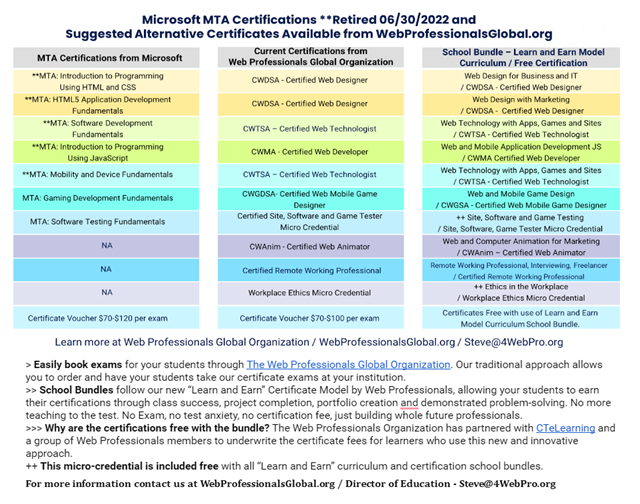 Click the above image to enlarge the Quick Reference Chart – Retired MTA Alignments
Click the above image to enlarge the Quick Reference Chart – Retired MTA Alignments
Our Approach
We have two paths to certification for schools and individuals. The first and traditional path is the proctored exam. Once a student is ready to get certified, they or their institution orders the exam, and then the student sits for the proctored exam. Most of the time the exam is taken at the institution where they are studying, or it may be taken at a designated site. Upon passing the exam, they are rewarded with their credentials. Cost for the exams ranges from $70-$100.
The second path is what we refer to as our industry-relevant certification model. In this model, we combine the interactive training with the certification. This allows the learner to earn their certification incrementally as they progress through the course. At the end of the course—based on their grades, completion of the projects, and building their career-ready portfolio—the learner is rewarded with their certification without needing to sit for an exam.
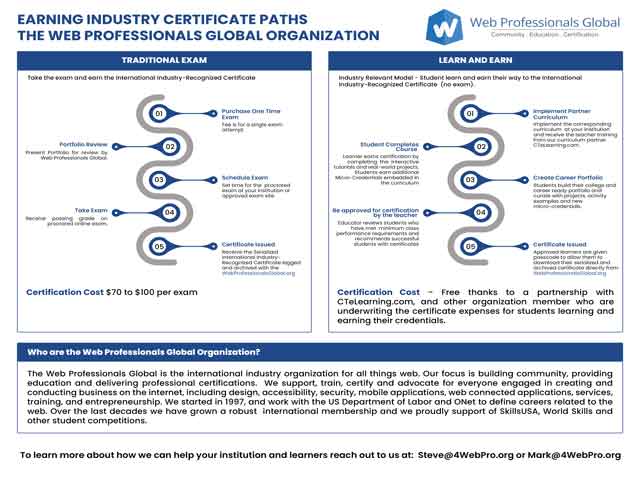 Click the above image to enlarge the Quick Reference Chart – Web Professionals Global Organization Paths to Certification
Click the above image to enlarge the Quick Reference Chart – Web Professionals Global Organization Paths to Certification
How Did We Do This?
We partnered with curriculum provider CTeLearning to supply schools with engaging STEM curriculum and certification bundles. The certifications we offer are more valuable than those offered by testing companies, as they measure knowledge and demonstration of skills—they do not gauge how well the student can memorize a list of questions.
Our embedded model has students earn their certifications as they work through the courseware and complete real-world technical projects. This approach removes test anxiety and results in certification recipients who know what it is like to build real projects and have a deep technical understanding of the technology.
Our certifications are not about any company’s software. They are about what a learner needs to be successful in the tech industry. This means schools do not have to worry about what software tools they are using, as the tools are all included with the curriculum for free. This allows course facilitators to focus on supporting students as well as focusing on creativity, problem solving and projects—not worrying about a software version. In industry, software is simply a tool. Tools are constantly changing, but design, development and creative problem solving are core to individual success. Our certs are about preparing students to be the “whole professional”—not someone who just knows how a piece of software operates.
Our curriculum bundle options can be a big money saver for schools and institutions. Thanks to a partnership between the Web Professionals Organization, CTeLearning and additional Web Professionals Organization members, the cost of the certifications are being underwritten for your students. This means that programs get the course and certifications for less than they paid for the Microsoft test vouchers alone.
Connect With Us Today
We are a community of professionals helping to drive the future of community, education and certification for web careers. Our certifications recipients and members span the U.S. as well as countries around the world in Africa, Europe, the Middle East and more. If you are a student or representative of a school who is seeking a certification program to replace your Microsoft program, we would love to talk with you. Our certifications can be deployed for your students immediately to keep them engaged and achieving.

by Steve Waddell | Jun 1, 2022 | Web Security
We often talk about web security because we believe it is an extremely important topic that will remain relevant for as long as the internet is around. If you missed it, we touched on it in our article on the next 25 years of the web. One of the most important aspects of security is password security.
Let’s dive into what security actually means. If you look at an environment like Moodle, your username and password are not only encrypted, but they are also encrypted with a salt value. A unique string of numbers, letters, and special characters are added, which is fairly long. And that is used to encrypt your username and password to begin. So when you log in, the data store retrieves the salt value, takes what you typed in, and marries those two together in a rather unique manner. It then encrypts it and compares that value to the value stored in the Moodle database. If they match (bit for bit), you’re in. And if not, you can’t get in. That in itself is a fairly high level of security. It is as close to military-grade security without two-factor authentication.
Here at the Web Professionals Organization, we maintain information in our learning management and certificate testing system. However, we are careful not to keep track of personally identifiable information. We only keep the student’s first name, last name and email. This is the minimum we need to allow students to self-enroll. We do not allow users to attach any phone number, address, social media links or profile names. In some cases, schools will ask that we completely anonymize the accounts, and for this we will create complex passwords and dead drop emails for each user.
If a hacker were to actually steal our data store, it would be useless because they would need to know the salt value. The salt value is stored in a different place—not in the database. The hacker would then have to be able to do a reverse lookup by using a rainbow table or something similar. And it would be impossible to do a binary reverse lookup. It’s just not possible today to crack those username and password combinations—and that’s by design.
How do hacks happen?
Let’s imagine we have a WordPress site that uses a MD5 hash. MD5 is a message-digest algorithm and cryptographic protocol that can be used for authenticating messages, content verification and even digital signatures. MD5 is quite secure. To hack it, you could create a rainbow table and start with lowercase “a” as the password. You would then encrypt that. Then you would store the value that you started with and the encrypted value in two separate columns. And then go on to lowercase “b”, “c”, “d”, and encrypt each of those. Then go on to uppercase “A”, “B”, “C”, and so forth. And then 1, 2, 3, and continue on (for example, a1, b1, c1). Obviously, the table gets larger and larger as you get more and more characters. For even eight characters, you are looking at a significant amount of data—multiple gigabytes, if not a terabyte.
So now you have these two fields—one field contains the safe value, and the other contains the encrypted value. Then you can download a data store from a WordPress site that’s been hacked. You would be able to see that there is an encrypted value and do a binary search on that encrypted value. Once you have the encrypted value, it can be found in the large table. And as easily as that you could have the username of “admin” and password of “123456” which you can use to log in.

Ensuring password security
It’s important to make it as difficult as possible to hack your accounts. Many people like to use their initials or identifiable information so that they remember the password. However, you can use random letters, numbers and characters in your usernames and passwords. In fact, many security experts recommend 15-20 characters. You can even go up to 40 or more these days. Sites like Correct Horse Battery Staple are helpful to create randomly generated passwords and allow you to set parameters. And encrypted password vaults like NordPass and LastPass are a good way to ensure password security without needing to write them down and keep track of each one.
There are all sorts of bad actors out there who have wide-ranging hacking capabilities and could likely hack into any of your accounts. However, most hackers will have trouble hacking into your accounts if you use unique passwords. It’s like someone walking down the street at night and trying to open car doors. If yours is locked, it’s likely they will move on to the next car that is open and leave yours alone. That’s what you’re doing by making it more difficult for people to get into your website or your information. You can even put your list of passwords on a USB stick or hard drive and avoid connecting it to the internet, thereby creating an extra level of security.
You can also make up answers for password security questions—for example, your mother’s maiden name—to make your accounts even more difficult to hack. Alternately, you could add a word like “flower” to the answer to each security question. For example, make of car “fordflower.” And you can use passphrases that you will remember (unrelated to your personal information), which can be helpful when utilized correctly. It should be said that you should be careful about revealing sensitive information anywhere on the internet—including social media. And you can use two-factor authentication and authentication apps for an added layer of security.
We should mention that we have never—and will never—sell student and member information to anyone.
Wrapping up
Whatever happens in the coming years in the world of security, the Web Professionals Organization will be here to help web professionals however we can. If you are interested in learning more about our mission, contact us today.

by Steve Waddell | May 24, 2022 | State of the Web, Web Design Trends
Mark DuBois, Executive Director of the Web Professionals Organization, shares his thoughts on the next 25 years of the world of the web and technology trends. Mark was asked to take over the organization in April 2016 and has been running it ever since as Executive Director. Click here for Mark’s reflections on the first 25 years of the organization.
I will be the first to say that trying to predict the future of what technology trends and the web will look like is difficult. So take all of this with a grain of salt. These are all my opinions based on 30+ years experience on this stuff. I will start by saying that the web is about documents. When I say document, I don’t mean text-based materials. I use the word document to refer to a package of knowledge—in other words, an association of images, words, videos, sounds that come together as an element of knowing or understanding.
We will always need packages of knowledge from the past to inform how we behave in the present and future. If you don’t know how to build a fire, it would be handy to have a “document” informing you how to do so. And there will be a continued need to access documents in whatever form they may be in.
When Tim Berners-Lee created the first Hypertext Markup Language prototypes, what did he try to do? His focus was on making information available to anyone on any device at any time. In my way of thinking, that’s where the mission remains today. When I started working with web technologies in 1992, there was no CSS, no formatting of text (except by the browser), and no behaviors like JavaScript. There will probably be other stuff that we haven’t even thought about that will happen in the next 25. We will remain focused on the fact that we’re dealing with documents—we will need to archive them and make sure they are available. We will try to meet that original requirement for people to access documents on any device, at any time.

With the web, ideas can cross generations. You can access websites and content on your phone, tablet, Chromebook, laptop, and desktop—you name it. There are all sorts of different ways, but to me, documents are the key. And I think if we focus on documents, there is always going to be a need for archival retrieval of documents. In my mind, that’s the core purpose of the web.
In the next 25 years, there is probably going to be a much greater need for document retrieval—and not just here on Earth. Whether we have some kind of colony on the moon or Mars or more space stations floating around, we will still have documents and need ways to retrieve them. And given the distance that could be involved, retrieval is not going to be instantaneous. Your tweet could take up to 10 minutes to get somewhere—and things may have changed by then, right? The point is that there will still be a great need for web professionals—in the next 25 years and beyond.
Additionally, in the next 25 years, it is possible that 100% of planet Earth will have internet access thanks to technology like SpaceX’s Starlink. Anyone with an internet-connected device will be able to create and consume content, even with an inexpensive internet-connected phone. We are already seeing in real-time the impact of this, as Ukraine has benefited from Starlink satellites.
Remote working will also continue to play a massive role in the global economy. Because of this interconnectedness, it will continue to be easier than ever before to work with people around the world. Over the past several years, a lot of companies and organizations have figured out that employees don’t actually need to be together in a physical office. They are saving tons of money by not paying for office space, utilities and more. And employees are usually happier working remotely. They can spend more time with their children and less time sitting in traffic traveling to and from work. The whole nature of work is changing, and we’re never going back to the way it was.
We’re past the revolution phase, where we have a world wide web and so forth. We’re now into the evolution phase, where it’s just going to keep growing. As much as I hate to use the term, the next version will be Web 3.0. However, even as things improve, we’re going to take a step back for every two steps forward. For example, look at blockchain—it’s like we’ve taken a big step backwards in terms of robust user interfaces and accessible interfaces. But that’s going to happen repeatedly, as things evolve over time and new technology trends emerge.

One of my big passions has always been security. And we keep making the same security mistakes that we have in the past, which must change. Security is so important because of the vast amount of data that is being created each and every day. And this data is gold to those who wish to get their hands on it. The information that’s in your documents needs to be reliable and secure. And combatting things like deep fakes in the coming years will be increasingly difficult and require entirely new tools and approaches. In the coming years, two-factor authentication will not be powerful enough to protect highly sensitive information.
Another interest of mine is accessibility, which I think is going to remain a big issue and one of the most important technology trends. Although interfaces are improving, they’re not there yet. For example, Apple’s Siri feature often resembles a drunk elf when you try to dictate something to her. So those areas still need improvement in the coming years.
It used to be that you had a little bit of knowledge. And you could make a career in a corporation, because you were a keeper of that knowledge. Today, the best way to make a career is to be the one who is able to curate the content and distribute the knowledge to others. Keeping information secure and accessible is a big part of this.
The whole merging of artificial intelligence with documents is going to require things like blockchain, to make sure that information is valid. The whole point behind blockchain is that you’ve got an audit trail—and that audit trail cannot be changed. And if you apply it in terms of documents, to me, that’s a way of dealing with some of this AI-generated deep fake stuff that I guarantee is out there.
We Support Web Professionals in Adapting to Technology Trends
Part of our mission is to continue to develop and support a thriving professional community who are connected to the internet and prepared to meet the next technology trends. We take a big-picture look to make sure this community remains vibrant and sustainable to reach the next level and help others for years to come. We will continue to work with students, teachers, and working professionals to meet their needs. In the web industry, you need to know how to run a business, bring value to clients, and execute on your promises. We are preparing current and future generations to do just that. As we mentioned in the article about the past 25 years, our mantra continues to be “Community, Education, Certification.”
To be frank, we don’t know where this is all going. We have always made our certifications good for two years because of how fast the industry changes. We at the Web Professionals Organization are in it for the long haul. We will continue to evolve and adapt to whatever the web industry will look like next year, in five years, and in 25 years. Many associations that began around the time we were founded are no longer around. We are okay making mistakes and being wrong about the future—but we will always adapt. We look forward to what the next 25 years hold for the web industry. If you are reading this and would like to be a part of tomorrow’s technology trends, reach out to us today.

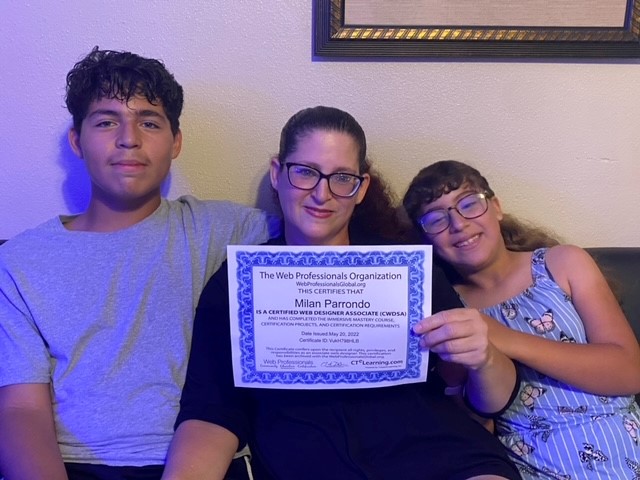
by Steve Waddell | May 23, 2022 | Member Profiles, Profiles Of Success
Are you interested in learning web design and earning an industry-recognized web design certification? Web design is a rapidly growing career pathway, and we at the Web Professionals Organization are proud to support many professional web designers in their career development.
We teamed up with our curriculum partner CTeLearning in recent months to reimagine how we administer industry certifications. Instead of having to pass a big certification exam, students meet certification milestones as they complete lessons and projects throughout the course—and earn their embedded certifications upon completion of the course.
Our Executive Director, Mark DuBois, noted repeatedly that we need to move away from the test-centric approach so common in academia these days. No one in business and industry cares about a specific test (especially one where the student prepares for the exam); they care whether the individual can do the job they were hired for. It is because of this reality we are moving towards portfolio-based certifications rather than continuing to focus on an exam. We want individuals to be able to showcase their accomplishments (and have that work reviewed by competent professionals). This is one more way our professional organization is responding to what business and industry are asking for. Mark says, “We are not a testing company (never have been and never will be). We want to confirm those holding our credentials are able to prosper in the industry.”
One of our latest certification recipients, Milan, is a mom who wanted to build her web design skills and knowledge. She is one of the first to earn a certification under the new embedded certification model. Milan gained skills, knowledge and certification as well as developed real-world web design projects—all from the comfort of her own home while being a great mom.
Like so many families, COVID-19 affected Milan’s family significantly. Milan, her husband and their children live in California and dealt with strict lockdown restrictions. Milan’s husband was an essential worker, and with that came long hours during the pandemic. Milan’s work was also hit by restrictions, and she and her husband began talking about making some changes to ensure their family’s future.
One of the topics they talked about is what it would mean to future-proof their family. Milan, a naturally curious type, had always had an interest in how websites worked. She told her husband that she had been watching YouTube videos, reading articles, and doing some activities on web design. Her husband had seen time and time again how his wife would take on new challenges and always give it her all. They both agreed that she would set her sights on becoming a web designer. Her kids were excited to know that this would mean their mom would be able to work from home in the future.
Milan reached out to her local workforce and met with a counselor. They looked at a number of programs, but Milan wanted a program with a certification that would mean something when applying for jobs in the web industry. The counselor suggested she take a course that would give her the opportunity to earn the Web Designer Certification from the Web Professionals Organization, which was a perfect fit.
In addition to the Web Designer Certification, she also earned the Remote Working Professional Certification. This micro-credential taught her how to become a remote working professional. It also taught her how to interview for remote and hybrid working positions, and as a bonus how to get started as a freelancer.
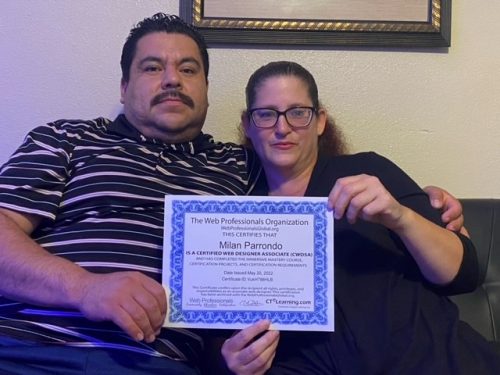
As Milan was working her way through the courses, she and her husband decided to start a side business with customized t-shirts for businesses, community events, family reunions and children’s parties. Her web design studies quickly became even more important as she and her husband began the process of launching their own business. She was no longer just a student, but the web designer for their family business.
A few months later, everyone in the family got sick—including Milan, who had to take a break for a few weeks before she could continue with the curriculum. However, she persevered and continued to build her skills and her career-ready portfolio.
When she was having trouble getting motivated, her daughter said, “Don’t worry Mommy, you will keep working on it. I’m really proud of you.” Her son chimed in and said the same thing.
Milan’s husband said, “I am so proud of my wife—I knew she would finish this course. My wife achieves whatever she puts in her mind. Our whole family is grateful she got this opportunity.”
We caught up with Milan to hear more about her experience:
What was it like being a working mom with a family and earning your credentials?
It wasn’t easy. I work and often come home late at night. When I got home I needed to spend some time with my family, make sure my kids were getting their homework done, and then I would work on my studies. When my son and daughter saw that I was doing homework, they tried harder on their own schoolwork.
How does it feel now that you have your certification?
I am ecstatic to have three credentials from this course—the Web Designer Certification, Remote Working Professional Certification and Ethics in the Workplace microcredential. Now I will have a chance to spend more time with my family as well as obtain a better job for myself. Before earning these certifications, I didn’t realize the impact it would have on my kids. Both my son and daughter see that I studied and learned what I needed to in order to get ahead. They both have told me so often how proud they are. My husband has told me how proud he is of me and how I am a great role model for our children.
What do you think about the courses and certifications?
I have already told seven of my friends they need to take this course—and just wait till they see the certifications. They will be so jealous!
As English is your second language, what was it like taking this course?
“At first it was a little scary. My Spanish is still much better than my English. However, the way the course explains everything with text and videos made it easy to understand. When I did have a question, my instructor Steve was always very helpful. He would often make a video to help me through what was confusing. I think I told you already that I recommended the course to seven friends. They are all like me—immigrants from Puerto Rico and Mexico—and I told them they could do this just like me.”
What is next for you?
I have already started on my next certificate with the Web Professionals Organization! I want to dive deeper into digital marketing—and with our side business being in t-shirt graphics, I decided my next step will be taking the Web Animation for Digital Marketing course and earning my Web Animator credentials. I’m excited to be able to create the social media animations we want to use to market our business as well as animated logos, banners and ads that my web design clients want. This is another way I can make myself stand out from the rest of the web design crowd—either as a freelancer or as a potential employee.
A New Approach to Web Design and ESL
Dr. Mauricio Castillo, a professor with California State University, Los Angeles, works with the Web Professionals Organization in their participation in SkillsUSA competitions. He is an expert in career and technical education and consults with companies on curriculum design and adapting courses to support English as a second language for learners in workforce development. He joined Steve and Milan on their Zoom meeting chat.

“I met Milan in the very beginning of her journey to get these credentials, and I have watched her progress closely. First, on a personal level I want to congratulate her on getting these certifications—she makes us all proud. As a professional, I will say that even though the course is in English, the way the course is designed and delivered does help support an ESL learner. I have been working with the curriculum developer CTeLearning since 2006 and I have deployed their courses at secondary and post-secondary levels with great success. We have even done some special projects at the middle school level in East Los Angeles. Although I do work internationally, my focus has always been in the Los Angeles area. Being bilingual, I often work with first-generation immigrants and programs to upskill and prepare them for high-demand and high-paying jobs. The content and delivery style coupled with an industry-relevant model for earning the micro-credentials and international industry-recognized certifications is ideal. Web Professionals Organization and CTeLearning have really, in my opinion, created something unique, special and impactful. So, congratulations to them as well.”
Interested in Learning More?
We are proud of Milan and all the members of our organization around the world. Check out the certifications we offer and contact us today to find out about a career in web design and how we can help you reach your professional development goals.

by Steve Waddell | May 18, 2022 | Member Profiles
What do you do when you want to retool for a new career? As an adult, you have more responsibilities and time pressures. Add to that the chance that at any moment you can get a call from school saying that your kids will be learning from home for the week or month or more, and it can be difficult to manage being a working professional.
Today we are highlighting one of our success stories here at the Web Professionals Organization. Eliza H. is a mother of school-age children who had to transition to working remotely because her children were home more due to frequent COVID-19 school closings. Over the years she has taken courses at her local community college to keep her skills sharp and continue to develop her career, and she is working with the Web Professionals Organization to continue that development and maintain flexibility to balance her personal life and professional life.
Eliza earned her Web Design certification and Remote Working Professional certification all from the comfort of her own home by taking the courses from the curriculum partner of the Web Professionals Organization, CTeLearning. She recently used those credentials to land a remote job as a web community developer and is now working on meaningful projects in the job of her dreams. In her interviews for the job, she was able to talk about the industry certifications she earned. She started on a Monday, knocked out four separate interviews all within a week and she was offered the job that Friday.
As a mom with two young children, these courses and certifications gave her the skills and knowledge to enter the tech field while maintaining her status as an involved mother. She still picks her children up from school, helps them with homework, and stays with them when they are home sick.
Eliza is very thankful to her local community college that set her up with this opportunity and gave her the chance to become certified web designer through the web design curriculum. With all the chatter today about the high cost of college, she shows how quickly you can upskill. No high-dollar boot camp. No expensive four-year school with big loans. And these certifications are built and backed by industry, not professional testing companies. Instead of having to take a high-stakes exam at the end of the courses, she completed project work through the courses to build her career-ready portfolio. Her training paid off when she realized on day one of the job that she already had the skills to succeed.
Right before she landed her job, we caught up with Eliza to learn more about her journey and dedication to professional development in the age of remote work.
What attracted you to web design and development?
Web design and development allow me to combine my passions—being creative and helping people. I love being creative and bringing ideas to light while helping people expand their businesses to reach other places and countries. I am currently focusing on the coding or backend side of websites so I will be able to provide customized website designs to each client.
What did you enjoy about your experience at the community college?
Community colleges offer fantastic value. It was an easy choice for me to first look at Washtenaw Community College to retool and get ready for the new reality of work. It wasn’t just the convenience—Washtenaw is part of our local economy, understands our community, has great teachers and is affordable. I really do love Washtenaw. I started taking classes back in 2006 when I was transitioning from one college to another. I wasn’t sure what I wanted to do, so I took some general education classes that would transfer. I love the small class sizes, and the teachers are excellent. I have gone back several times to take classes and have never had a bad experience.
How has your experience at the community college shown you how important it is to continue to develop your skills as a professional?
I previously worked in an office and took classes at my local community college that taught me the skills I needed to be good at my job. Now that I have my Web Design certification, I am taking even more courses. The information that I am learning is up-to-date and valuable in the job market.
How has taking the Remote Working Professional course and earning the certification empowered you as a working professional?
The Remote Working Professional course provided guidance on how to set up my day-to-day operations while working from home. Now that many jobs have moved to being remote, we need to learn how to make home the new workplace and also be able to separate work life from home life. I have worked from home in the past doing tech support, and this course has provided me with further knowledge and an industry-recognized certification on how to work remotely and be successful. I like that this was something I could do during the kids’ nap time or when they were at school. The information was easy to digest and I could easily pick up where I left off.
How has the course and certification changed your view of global connectivity and people being able to learn and work remotely from anywhere?
I think we are digitally connected more than ever. The Remote Working Professional course shows others that I have the skills to work from my home office and excel in a variety of roles.
What skills did you learn in the course about working remotely that you would share with a hiring manager in a job interview?
I would tell them about my home office that is secluded from the rest of the house, which ensures I have limited distractions during the day. I would also tell them about how I am more productive working at home since I don’t have a commute.
What does the term future-proof mean to you now?
Future-proof means being able to have an in-demand flexible career and business that I can work on when I want to.
What have you learned about how to balance being a mom with school-aged kids with being a working professional in the remote economy?
I love working remotely because I have time to get tasks for work and home done. I can take a quick break and go change laundry loads or take the dogs out for a walk. I can pick up my kids from school if I need to. Being able to get home tasks completed allows me to focus more on work. I end up getting more done than if I had to commute.
What have you learned that you would pass onto your kids to help them excel in the classroom as well as in their future professional lives?
It is important to make a schedule and follow it. Set times to focus on work and times to take breaks. Great time management can make you stand out and be more productive. With the pandemic, it is more important than ever to be able to learn and work productively from home.
What would you tell other parents who are considering career changes?
Don’t be afraid! You have to come up with a plan of attack to get where you want to go and then follow it. Don’t let doubt get to you. Find something that you are passionate about so that work becomes more like play. Get paid to do what you love.
Reach Out To Us Today
We are proud of Eliza and all of our students who strive to further their professional development, no matter what stage of life they are in. Contact us today to find out more about us and how we can work with you to help you achieve your goals.

by Steve Waddell | May 6, 2022 | Member Profiles
Today we are highlighting Amy F., one of our most recent Web Professionals Organization certification recipients. She earned her Certified Web Designer (CWD) and Certified Remote Working Professional (CRWP) certifications as well as an Ethics in the Workplace microcredential, all from the comfort of her own home. She can use these credentials and her robust portfolio of web design projects in future interviews with potential employers or as a base to launch her own business as a freelancer.
MyCAA—also referred to as the My Career Advancement Account— is a program that provides tuition assistance for courses and certifications to military spouses. Amy was able to utilize the MyCAA program, and we are proud to be associated with this program that helps military spouses succeed. We have worked with countless military members and spouses over the years to help them earn certifications, and they are always among our most driven and hard-working students. As a military spouse, Amy is a great example of why we offer online certification programs.
We caught up with Amy to ask about her experience taking courses and earning certifications as a working professional.
What initially attracted you to web design and development?
Coding reminds me of math in a way! The beauty of math is that it’s either right or wrong. I love that! As I learned about coding, I realized it has operations of its own, a set of rules that need to be followed. I find that relaxing.

As a military spouse, what did you enjoy about being able to complete the courses and certifications fully online?
I really appreciate that this class was fully online! I also liked the schedule flexibility as well as the ability to work on the certifications at my own pace and from wherever my husband and I were stationed at the time. We underwent a permanent change of station (PCS) move while I was in the middle of the courses, and I was able to continue working seamlessly.
How has taking the Remote Working Professional course and earning the certification empowered you as a working professional?
I’m fortunate that this course also offered a Remote Working Professional (RWP) Certificate. I’m excited about the future and the jobs I will be able to get now that I have a RWP certificate. I plan on working remotely so that I don’t have to look for work each time my husband and I change locations.
How has the Remote Working Professional course and certification changed your view of global connectivity and people being able to learn and work remotely from anywhere?
I love the fact that I can work for a company based anywhere in the world.
What skills did you learn in the Remote Working Professional course that you would share with a hiring manager in a job interview?
I learned a number of skills. To name just a few:
- Communication: well-mannered verbal and non-verbal communication as well as sending post-meeting recaps to avoid miscommunication are important.
- Organization: using a planner and setting a timeline.
- Ethics: adhering to commitments, showing empathy, and being respectful, honest, transparent, and accountable.
- Initiative: doing the job right and on time.
- Preparation: being ready for technology failures.
- Cultural sensitivity: understanding different cultural norms by researching before engaging.
- Cybersecurity: how to maintain safety and privacy.
How has your experience earning these certifications improved your confidence in being able to work from anywhere as a military spouse?
My mom and dad always tell me they’re proud of me…but that’s their job. I took the course so I could be proud of myself.
What advice would you give to others who are considering earning certifications to future-proof their careers?
The same advice my mom gave me: “The time is going to go by anyway!”
The internet, business, and marketing are all closely intertwined together—how do you think the courses and your new certifications will fit into your future plans as you go on to finish your business degree?
I will be graduating with my BBA this summer (woo-hoo)! Through my education I have earned experience, skills and qualifications that show I am capable of learning. After this summer, I plan to use my degree and certifications to land a nice job!
You have taken a number of courses online—what stands out about these courses?
I really enjoyed both courses! I like how well CTeLearning organized the courses, as each lesson helped and prepared me for the next lesson. I also liked how during each lesson I was able to apply the information I learned. In the Web Design course I was first shown how to write the code, then I did it myself. Thank you for teaching in a way that I can have ownership of my knowledge! And thanks to the Web Professionals Organization for the integrated certifications I now have!
Mark DuBois, Executive Director of the Web Professionals Organization, said, “Amy is another great example of a MyCAA success story. I am proud of our military leadership for thinking about the whole military experience—not just for the service person, but for their spouses and families as well. I think it is a brilliant idea that we, as a country, invest in educational opportunities for military spouses. Our servicemen and servicewomen and their families sacrifice to maintain the security of our nation. Helping spouses gain marketable web technology skills so that they can move as duty requires helps make the family unit stronger and more resilient. MyCAA is money well spent. Everyone who has been a part of this program who has gone through the education and received certifications from us has been exactly the type of person employers want to hire. Congratulations again to Amy. We thank Amy and her husband for all they are doing to contribute to the safety and security of our country.”
If you would like to earn certifications and learn skills that can make you a more marketable professional, check out our certifications list and contact us today. We would love to chat with you.
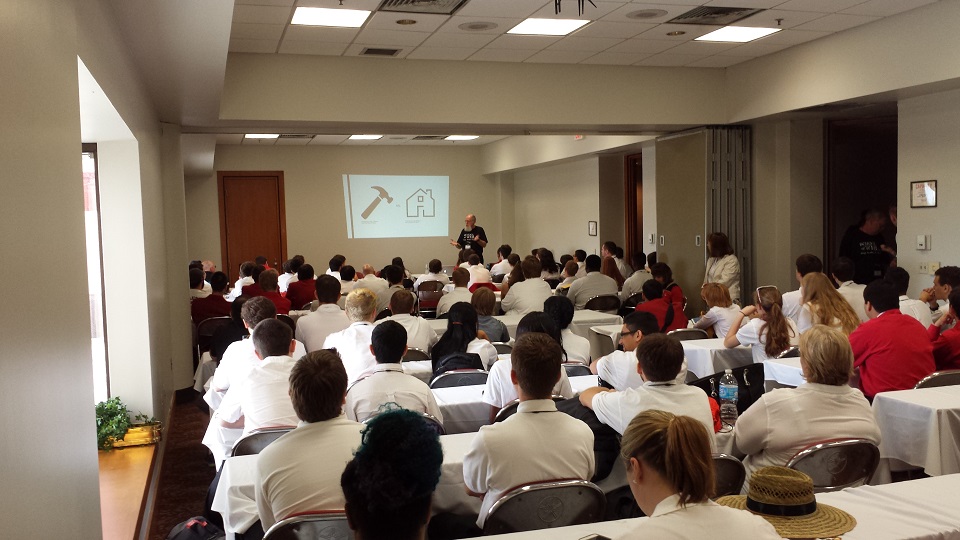
by Steve Waddell | Apr 29, 2022 | Web Pro News
Mark DuBois, Executive Director of the Web Professionals Organization, shares his reflections on the 25th anniversary of the organization. Mark was asked to take over the organization in April 2016 and has been running it ever since as Executive Director.
I
The Web Professionals Organization was originally founded as the World Organization of Webmasters (WOW), which was established in April of 1997. The founding Executive Director, Bill Cullifer, was a webmaster who was early to the scene of web design. Bill saw a need for the burgeoning wave of webmasters, content creators, and new internet businesses to come together in a community to share, collaborate and propel the web profession forward. Bill pitched his idea to many companies, and three of the largest gave WOW their start-up grants. We are still thankful to Adobe, Microsoft and Macromedia for our initial funding. The organization was registered as a 501(c)(6) organization, and the early years were full of growth. Bill Cullifer was deeply involved in growing the organization as Executive Director until 2015. He bowed out due to illness, but his legacy lives on.
The mid-1990s was kind of the wild wild west of the web, if you will. In 1992 I built my first web page, which no longer exists. I first came across the World Organization of Webmasters in 2001 in Chicago. I had been working in web technologies for a while at that point and created many websites including one for a multibillion-dollar utility company in 1995. Four years later, I felt a need to do more. It was then that I decided to give something back to the community. Like so many others who feel the call, I decided to teach the next generation. So in 1999 I started teaching at the local community college, and met some folks from the World Organization of Webmasters at a conference a few years later.
Coming from industry, I liked what the organization was doing. I began to seek ways to get more involved, so I took some certification exams and established a local chapter at the community college I taught at. I guess I made a name for myself and my program because a few years later, in 2006, I was offered and accepted the role of Director of Education for the organization. Remember that this was still early in the industry—I became an officer of the association the same year Steve Jobs announced the iPhone.
Under Bill’s leadership in the early years, we participated in many meetings of the World Wide Web Consortium (WC3) at various venues around the world from Edinburgh through Beijing. It was at these meetings that we gave presentations and had the opportunity to meet with a number of luminaries such as Sir Tim Berners-Lee, known as the inventor of the world wide web. These events were key in expanding the reach and influence of the organization—especially internationally.
Around 2006, I took my students to a web design competition in Springfield, Illinois that was held under the auspices of SkillsUSA. That was a state competition, as there was no national web design competition. I felt that the competition was not run as well as it could have been, opened my mouth, and the conference organizers invited our organization to run it ourselves. So that’s what we did. In 2002, we had a much-improved web design and development competition, where students actually had to compete at the state level. The Illinois SkillsUSA chapter loved what we had done, which got the National SkillsUSA executive team to take notice of our organization.
In 2004, the organization collaborated on our first national demonstration competition for web design and development. And we had a number of teams that competed in that initial competition— it was something like 12 or 15 teams of secondary schools that competed. At this point it was no longer a demonstration contest—it was official. And we’ve been doing the national web competitions for SkillsUSA ever since. I was responsible for competitions through 2008, when I passed it to a former student of mine named Jonathan. He has been doing it ever since for the state of Illinois. We have never missed a year and even continued to run the competitions, albeit virtually, through the COVID-19 pandemic. We are committed to giving students access to competitions run by industry professionals.
As an organization, we decided early on to get involved in web competitions to highlight industry best practices. Our experience with all the workshops, teacher training, and seeing what student competitors produced showed us that many schools don’t teach the business fundamentals that are so important in addition to technical skills. Because of this, we decided that the best way to drive professional standards is to have students compete at both the state and national levels. In our competitions, the students’ code has to adhere to international web development standards for them to have a chance to win.
Prior to the national competitions, all competitors participate in mandatory training so they are exposed to new concepts. We enjoy seeing the competitors discover that they don’t know as much as they think. This has helped us drive our message of professionalism and expand our influence as the competitor-students go back to their schools and encourage their teachers to teach industry best practices. We know this works as more teachers ask us about industry standards every year. Little by little we are helping secondary schools prepare future professionals, which is a big part of our mission.
II
In 2009, we were invited to be a part of the Web Standards Project, which unfortunately has been archived and is no longer active. We were thrilled to participate, as web accessibility and security has always been a focus of the organization. That year the meeting was held in Chattanooga, Tennessee with a number of people who were responsible for web standards. As you may remember, back then there were a number of different browsers emerging like Internet Explorer and Netscape. In the early 2000s, each browser came up with their own browser codes— there was the blink tag from Netscape, the marquee tag from Internet Explorer, and so forth. And the Web Standards Project was created to establish that all browsers implement similar code so that web designers could create websites that would work on any browser. This was something I felt strongly about, and I was delighted when I was chosen to be co-chair of the Education Task Force for the Web Standards Project.
Working with Adobe and a number of other companies, we established the criteria for what curriculum should contain. And this became the career cluster for things like digital media that are out there today. If you look it up, you’ll find there’s a digital media career cluster. This provided the impetus for us to work with the Department of Labor around 2011. We also worked with professors and universities around the U.S., including John Gunderson of the University of Illinois, to do seminars and events about web accessibility. We also worked with the WordPress team on their accessibility task force.
One of the biggest pushes for the Web Professionals Organization has been certifications. As we are made up of industry professionals, we had plenty of contacts to help us develop what would become our international industry-recognized certifications. With the blessing of our whole certification team we started to issue industry credentials in 2001. Back then, everything was paper-based. When I later became Director of Education, one of the first things I did was eliminate paper and make it all online. We thought this was a big step forward to modernize the organization and make it easier for more people to earn certifications. From 2006-2008, we had meetings in Las Vegas, with people representing businesses, workforce, secondary and post-secondary schools to define what should be taught in the way of curriculum as a general outline, and what should be covered in terms of certifications, technical skills, soft skills, and more.

As a professional organization, we take credentialing seriously. The first certifications we offered were designer, developer, and webmaster. Today, we are proud to offer far more. What constitutes a web professional is far more diverse and demanding than back then. We do not teach to the test—you cannot find a sample test out there that you can practice with. For our professional levels, we ask to see examples of his or her work. For secondary and post-secondary students, we asked the teacher to assemble a portfolio of their work. To us, certifications signal that someone has the ability to produce and pull their weight in the industry—it does not mean that they are capable of cramming for an exam.
As an aside, I have been in the industry and education for decades. I have seen it all and understand what does and does not help the web profession. Testing companies will give you samples of their exam, and often will sell you a book to use to prepare for the exam. These exams usually have little to no basis in industry standards. We are proud to have higher standards than just scoring well on an exam that you can study for from a book. We are not so much about the number of professionals we welcome into our organization, but the quality of those professionals.
We have continued to make our certifications good for two years. Some have asked why they are not good for longer. It is for the simple reason that the world of the web changes so often that we must always be learning new skills. We are always focusing on the fundamentals. Frameworks come and go—we could make a list of those that have come and gone in just the last couple years. All that said, we focus on giving people a professional foundation that allows them to continue growing and adapting. We are about building true professionals.
A quick story: there was a high school that had a number of students earn apprentice-level certifications, and they did well. That teacher retired and they were replaced by somebody from a different department. The following year, 100% of their students took the exam. All 30 students failed miserably. The teacher called me and was apologetic. And we discovered in a very short order that the teacher was not teaching what the students needed to know. The teacher had just grabbed a book and focused on just coding and nothing else. However, the next year they turned it around by focusing on the appropriate things in the following year, and the majority of students passed the certification exam. Educators seek to develop whole learners, and we want to grow whole professionals. Our expectation is that the certification represents the fact that students have the knowledge and portfolio to demonstrate proficiency.
III
In-person meetings have also been important for us. We haven’t been doing as many in recent years because of COVID-19, but fortunately we understand how to use the internet to stay connected. Our members are webmasters, developers, and technologists from schools and companies of all sizes all over the world. Just as the internet is international, so is our organization. We work with schools and professionals in the Middle East, Africa, Europe, South America, and Asia. In addition to helping schools, we also help workforce partners train and re-engage adults in high-demand web careers. We are constantly working with industry and education partners to understand how we can better serve the web professional community, and it’s why we are industry-driven and industry-recognized.
Around 2010, we started the School of Web. We included a lot of the course materials that I had put together at the community college level, as well as courses from professors at other schools. We started the School of Web because in conversations with industry people we realized there was a hunger to develop their skills and knowledge. This started our efforts to offer micro-credentials.
One of the main drivers behind all of this, which is still somewhat true today, is that the term “web developer” can have different meanings. If you look at two job listings for a web developer, one may be looking for someone with HTML and CSS while the other may be looking for someone with a solid knowledge of a number of JavaScript frameworks. So our certifications and micro-credentials establish a baseline that any web designer or developer should have in their skillset. A big part of why the web technologies industry evolves so much is that there isn’t a set of standards for credentialing like different states have for medicine or law. And we’re seeing some improvements on that. Today, we are proud to have certification recipients and members not only all over the U.S. but also around the world in countries like Albania, Germany, Nigeria and Lithuania.
This year, we have begun to expand to doing more state competitions within SkillsUSA. We have seen early success so far. We’re trying to bring the state competitions to a new level of excellence, so that those who participate are better prepared before arriving at the national competition. For the national competition, each state can enter just one team at the secondary level and one team at the post-secondary level. By getting involved with these state competitions, we are now impacting many schools around the country.
We continue to go out of our way to build community and get people involved—everything from Slack channels to local chapters that meet. We strive to make sure our members have a solid understanding not only of web technologies but also best business best practices. We also have expanded our international presence— we have participated in the international WorldSkills competition, starting in 2013 in Leipzig, and we have had international members on our advisory board. Our mantra continues to be “Community, Education, Certification.”
It has been a wonderful 25 years for the Web Professionals Organization. When we started out, the web was in its infant stages. Today, the internet is more integral than ever to people around the globe in industries ranging from manufacturing to education and healthcare to energy. People work, learn, and play on the internet every day, making our mission more relevant and important than ever.
Stay tuned for a future article on where the Web Professionals Organization would like to go in the next 25 years. And if you would like to get connected, please contact us today. We are always seeking to expand our ranks both nationwide and worldwide and look forward to connecting with you.


























